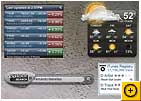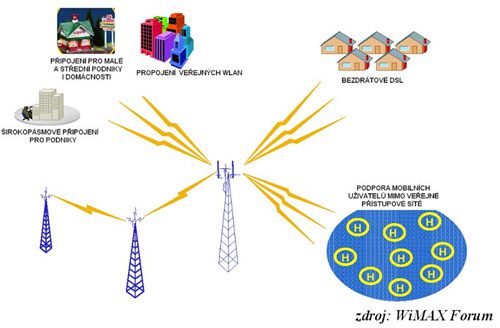It seems that 2006 will bring a series of significant changes in how people work and entertain themselves: Web applications and modern tools will further blur the lines between desktop computing and the Internet.
The next generation of DVDs will “land” with large capacity discs of exceptional quality. Large LCD screens will become even more beautiful and attractive while prices continue to drop. Finally, the tech giant Microsoft is set to release the much-anticipated Windows Vista operating system by the end of 2006.
However, the road to “glory” appears to be rocky and full of potholes. A fierce battle over standards is ongoing among new generation DVD technologies. Vista will require a powerful system to run smoothly. Furthermore, most new screen models will come with a price that the average person can only dream of.
1. Windows Vista
 Microsoft’s next operating system looks very different from the Windows version you are currently using. However, the technological changes inside are far more important.
Microsoft’s next operating system looks very different from the Windows version you are currently using. However, the technological changes inside are far more important.
It has been 10 years since Microsoft launched Windows 95. Now, the company is gearing up for another pivotal moment: Vista – expected to be released by the end of 2006 – with its “philosophy” centered on security, security, and more security.
Microsoft has put a tremendous amount of effort into Vista to ensure users are 100% protected from all types of malware, viruses, and other malicious attacks, as security issues have been a persistent headache for the past decade. However, Vista is not just about security. It also brings more exciting gaming features, enhanced desktop search functionality, a revamped user interface, compatibility with high-definition TVs, and a host of other multimedia features. Moreover, Vista will be Microsoft’s first mainstream operating system designed to run 64-bit applications.
There are many rumors about Vista’s market entry (which Microsoft has yet to comment on): Vista will be released in various forms, from “stripped down” versions for the third world to fully-featured versions for businesses.
Microsoft engineers have introduced numerous initiatives to tighten security for Vista: First, creating “limited user” accounts will be easier – meaning that a user will have only basic rights (to download graphics but not to install applications). Currently, only the network admin has this privilege in existing Windows versions.
Another measure is that for the first time, Microsoft allows the operating system to encrypt all data on the hard drive by default. Many applications and peripherals will also be isolated so that if a virus from Internet Explorer infiltrates the system, the level of damage caused will be minimized.
If Windows Vista performs as Microsoft has promised and as the beta has shown, it will indeed be a true upgrade.
2. The Blu-Ray vs HD-DVD Battle
At this point, DVD technology has become too mainstream – many players even cost as little as $30. This is precisely why the tech industry has decided to make a change. Wondering why? Ask yourself: do you still want to listen to cassette tapes? Certainly not, and who can say that by this time next year, you won’t feel the same way about your existing DVD collection?
 The next generation of DVDs is expected to hit the U.S. market in 2006 to match the quality of ultra-high-definition TVs. Two new DVD formats: Blu-ray and HD-DVD will offer you near-perfect image clarity. Additionally, their storage capacity far exceeds that of current DVDs: while a Blu-ray disc holds 25 GB (for single-layer) or 50 GB (for dual-layer), HD-DVD stores 15 GB and 30 GB. With 25 GB, you can record 120 minutes of high-quality TV shows or 13 hours of standard-quality TV.
The next generation of DVDs is expected to hit the U.S. market in 2006 to match the quality of ultra-high-definition TVs. Two new DVD formats: Blu-ray and HD-DVD will offer you near-perfect image clarity. Additionally, their storage capacity far exceeds that of current DVDs: while a Blu-ray disc holds 25 GB (for single-layer) or 50 GB (for dual-layer), HD-DVD stores 15 GB and 30 GB. With 25 GB, you can record 120 minutes of high-quality TV shows or 13 hours of standard-quality TV.
The only issue is that these two formats are in a “war“, dragging along a battle among film studios. Each studio chooses to support only one format, meaning that if you watch movies from Walt Disney, like “Herbie: Fully Loaded” or “The Witch“, you won’t be able to watch “The Bourne Supremacy” or “Chronicles of Riddick” – both products of Universal.
3. Next-Generation Web Applications
Before long, you will enjoy interesting, lightweight websites that operate just like desktop applications.
 For most of us, going online means opening a browser and surfing through various websites. However, the latest advancements in how Internet information interacts with desktop computing will require you to change your perception of being online.
For most of us, going online means opening a browser and surfing through various websites. However, the latest advancements in how Internet information interacts with desktop computing will require you to change your perception of being online.
Many people call this new technology Web 2.0. Others refer to it as “Open API“. Regardless of the name, what matters is that 2006 will witness a surge of new web applications built on this technology.
Some names may already be familiar to you. The website Widgetgallery.com (formerly Konfabulator) offers over 1000 small applications that run smoothly on your computer but are built using JavaScript and XML, just like many websites. Many of these applications rely on web information to function. For example, a lightweight dictionary software displays search results from top dictionary sites.
Google Maps is another familiar variation of the Web 2.0 concept. This service uses Ajax technology to allow users to seamlessly navigate maps in any direction through simple click-and-drag actions.
However, the limitation of this technology is that not everyone can maintain a 24/7 Internet connection. Don’t get your hopes up too high; think more realistically. Simple web applications merely add more options for you.
4. Screens: Brighter, Faster, Wider The future looks bright for the display market in 2006. Depending on your budget, you can purchase a screen with corresponding brightness levels. If you’re willing to spend $7000 on a SpectraView LCD 2180WG, the first LED-backlit monitor from NEC, you will know what true brightness, vibrant colors, and real contrast are.
The future looks bright for the display market in 2006. Depending on your budget, you can purchase a screen with corresponding brightness levels. If you’re willing to spend $7000 on a SpectraView LCD 2180WG, the first LED-backlit monitor from NEC, you will know what true brightness, vibrant colors, and real contrast are.
Compared to traditional screens, LCD screens are usually dimmer. This is when manufacturers race to increase the brightness of new models, as the LCD market has become saturated. LED technology seems to be a lifesaver, as it not only improves brightness but also provides more accurate color representation due to a wider color gamut.
“Current LCD models can only display 70% of the color standard, but with LED technology, you can exceed that standard to achieve high-resolution colors,” said an analyst from IDG.
However, the cost of next-generation screens will still be quite high in 2006. You can expect a more affordable product by 2007.
5. Wireless Connectivity Everywhere
After the initial excitement, you realize that finding a public Wi-Fi hotspot is not easy at all (except in a few upscale cafes). But starting next year, finding a connection point will be much easier, thanks to Intel’s long-range broadband technology called WiMax. According to the company’s spokesperson, WiMax signals can cover a range of up to 50 miles in testing, and in practice, even more than that.

The first WiMax version to hit the market will be “Fixed WiMax“, which includes a tower that emits WiMax signals and a WiMax router to receive the signals. A Wi-Fi access point will relay the signal within a 150-foot range. The “Mobile WiMax” version won’t be available until late 2007, at which point compatible notebooks will be able to receive signals directly from the tower without the need for intermediary routers.
Heavenly Will


















































